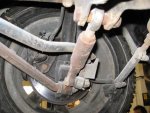My 504 Berline marathon rally car is finally ready, after more than a year in the making! I had big dreams for this purpose-built car, so two years ago I wrote a wish list for the “ultimate marathon 504” build. The idea was to use all the knowledge and works parts accumulated over the years, plus whatever new parts were necessary, to build the best possible marathon 504 regardless of cost. We decided to adhere to the FIA homologation rules, so the car has an HTP (historic technical passport) which qualifies it to participate in any FIA sporting event. After nearly a decade of building and rallying 504s, and having a works 504 V6 coupe in the shed for reference, we had optimized the engine, drivetrain and suspension, and identified the potential problem areas. The build process was very smooth with no surprises, and the car breezed through its first major shakedown (which quickly turned to an extended caning). Here is a brief summary of what we did:
Chassis: I have always felt that weight is the enemy, not only because of the power to weight ratio, but also because of handling (inertia) and the beating the chassis and suspension of a heavy car take on gravel. The 504 Berline is not a light car; the showroom stock weighed in at 1280 kg, and the works Safari Berlines at 1370 kg. My 504 V6 works coupe weighs 1270 kilos stripped of a spare wheel, diff protector, and tools (which is how I normally rally it to keep the weight down). For the marathon car we stripped as much weight as we could without compromising chassis integrity and adherence to the rules. All unnecessary components were removed, including some sheet metal, and lightweight materials such as polycarbonate windows were used in place of showroom stock. I was amazed and delighted by the end result: 1142 kg with a full length sump and transmission guard, a differential guard, 75 liters of fuel, two spare wheels, and a full tool kit! The chassis and cross-members were seam welded in key areas, and the rear cross-member and diff top cross-member rubber mounts were replaced by rigid Ertalon mounts. The lighter chassis makes the car feel far more toss able and responsive to corrections than the 128 kg heavier works coupe.
Engine: We built three engines for this car: A low compression, 123 bhp engine that can tolerate poor quality (around 85 octane) fuel. A second engine, which is now on the car, 158 bhp, but heaps of torque at 2300 rpm, max power at 5300 rpm and runs on standard pump fuel. The performance belies the modest power numbers, the car is very quick; it easily keeps up with 911’s on mountain roads and really shines on gravel. The idea is that this marathon engine should cover 1,000 km per day, for 30 days with only routine service. The third engine is a 181 bhp rally engine that runs on 100 RON fuel and revs 1200 rpm higher than the marathon engine; it is also quite noisy with its side exhaust, but will give ANY car a run for its money on gravel. All three engines have flowed and port-matched heads, custom camshafts (unique to each engine) with matched high performance valve springs and adjustable sprockets, forged pistons (with varying dome volumes), o-ringed liners, lightened flywheels, and annealed copper gaskets. The marathon and rally engines have oversized valves. We went all-out when it came to engine cooling. In ten years of rallying 504’s, the only problems we had (not counting off-road excursions and BA7/5 transmission blow-outs) were from overheating; we either blew head gaskets (hence the switch to annealed copper gaskets) or had to slow down to preserve the engine. We adapted a huge aluminum cross-flow radiator to suit, and we put a venting mechanism on it so the system can be depressurized, and even topped off when hot. Frontal radiator area is 80% larger than stock and coolant capacity more than double. The mechanical fan on the water pump is fixed for constant operation, and there is a thermostat (and switch) activated electric fan. The oil filter has been relocated for maximum cooling, the oil pump is modified to deliver higher oil pressure, and we installed the largest oil cooling radiator we could fit. We replaced the stock grill with a custom-made mesh unit to protect the radiator and oil cooler from debris. This was a lesson learned from experience: Years ago we caught up to the car in front of us in a gravel stage, and stones thrown by its wheels punctured our radiator. The cooling system works great; after 50 km at rally pace, water and oil temperatures were a steady 75 degrees, and the electric fan stayed off the entire time. With the old radiator (standard 504 with a third row added) and nine row oil cooler, the electric fan would be in full operation, water temperature would be at 90 degrees and oil temperature at 100 or more, after such an exercise. The other known 504 problem is a broken alternator belt tensioner (with the ensuing problems), mostly after extended gravel duty. The works cars used two overlapping tensioners, but I noticed that the back one had cracked anyway. We had tensioners CNC’d out of 5mm steel for all the cars and haven’t had a problem since. Another problem with hard-working 504 engines is oil vapor pressure build-up, which eventually leads to oil leaks through the crank shaft pulley; we installed a pressure relief valve on the valve cover to prevent that from happening. All engines have electronic ignition; distributors were dyno re-profiled for each engine. We focused on redundancy: two fuel pumps that can be dashboard-switched on the fly, twin throttle cables, twin ignition coils, twin ignition modules; the objective being to not have to slow down or wait for parts, hopefully for 30,000 km.
Gearbox and torque tube: The gearbox is connected through a six-paddle clutch and heavy duty pressure plate. We kept destroying BA7/5 boxes so we opted for the far more resilient BA7/4 gearbox and we fully reconditioned one for the task. We also have a BA10/5 from a 505 turbo that can easily handle the torque of the rally engine and provide lower rpm cruising, but this comes with a significant weight penalty so we are sticking with the BA7/4 for now. The driveshaft and torque tube are the heavy duty versions from a 505 turbo. The shifter has been modified to a quick shift unit with much shortened throws. The problematic Peugeot shifter linkages (they have a habit of popping out during special stages) have been replaced with top quality joints on 10-10 steel.
Exhaust: All stainless steel, dimensions optimized on the dyno (we went through four iterations over the years). Big 4-2-1 extractors, 60 mm exhaust now on the car. We also have a set of 4-1 extractors and a 70mm side exhaust, these give a more peaky engine suited to bitumen rally stages and are intended for use with the rally engine.
Electrics: We went all out with an aircraft dashboard and wiring loom. All switches, fuses, and relays, including spares, are within easy reach by both driver and co-driver with fuse and relay legend stickers on dash cover and overhead. Rev-counter with built-in adjustable shift light, voltage, water temperature, oil temperature, and oil pressure VDO gauges, 12V/twin USB charging ports, oversized oil pressure light, low oil pressure warning buzzer.
Front end: This came from our works spares container, and was McLaren-designed for the later 504 V6 coupes. The steering rack is 2.9 turns lock-to-lock. The LCA’s are modified with uniball joints; this allows control of track width and camber. All bushings have been converted to top quality polyurethane. For shocks, we opted to keep the modified works oil inserts rather than use our usual custom Bilsteins. We have yet to find something that works better than the works inserts on gravel, plus, contrary to the Bilsteins, they require very little maintenance (remember that this is a marathon car). We just used the latest technology racing suspension fluid from Silkolene, as we found that the heavy hydraulic oil used by the works team overheats in gravel stages longer than 15 km. We had replicas of the front works springs made with more modern, durable alloys. The works cars used a 26mm ARB, but we found that the 28mm from a 505 turbo performs better, so we switched to that. We matched the ride height of the works coupe, which is 20 mm higher than the production model. Over the years we have found that Berlines with strut tower bars handle better, so we had one custom-made from T5 aircraft aluminum. We also installed custom uniball top mounts with camber adjustment bolts; the stock rubber top mounts are often destroyed on gravel and the strut goes through the hood. All wheel studs have been replaced with longer, stronger 140/15 units modified from a Nissan SUV; the standard 120/12.5 used in the Berline are too short and the thread easily damaged.
Rear end: From a works 504 V6 coupe, it widens the stock rear end by 55mm (guard lips had to be rolled). Works 4.11, 45/60 limited slip differential with works capped steel mounts. Springs are custom made Eibach. The ones now on the car are for rallying, for marathons they are replaced with taller/stiffer springs designed to handle an additional 100 kg of luggage and spares. The shocks are modified heavy duty triple tube shocks from a two and a half-ton V8 SUV. They look really beefy compared to the standard shocks and they are nine-position externally adjustable to adapt to varying rear load and spring stiffness.
Brakes and wheels: Braided flexible high pressure PTFE hose (all lines inside the cabin), Tilton seven-position brake proportioning valve. 505 calipers front and rear, EBC Yellow-stuff brake pads. Handbrake modified with a push-button lock pin for either fly-off or standard operation. The car stops exceptionally well with no trace of fade, even after long downhill stages. The entire wheel stock is from 505 models and contains six of the very durable and rare 15 inch steel wheels, four 15 inch aluminum alloy wheels, eight 14 inch aluminum alloy wheels, and four 14 inch steel wheels. Wheel selection depends on the condition and average speeds of the stages.
Fueling: 77 liter aluminum explosion-proof tank with sump and safety foam. The fuel level sender does not work well with safety foam, so we installed a fuel-level sight tube on the tank. The twin electric fuel pumps are connected in line as this gives a more efficient filtration through the screens, and we felt that at times fuel quality will be questionable. We also installed a glass in-line filter between the tank and the pumps as an additional precaution. Debris will be visible and the filter can be cleaned and re-used. A fuel pressure regulator is mounted on the engine firewall and it contains a water separator. The fuel lines are inside the car, braided, and suitable for ethanol-containing fuels. The carburetors are 45 mm Weber DCOE’s for the marathon and rally engines; the low compression engine uses a double barrel 48 mm Weber IDF on an Argentinean manifold. The marathon and rally engines have 40mm chokes, the low compression engine 36mm chokes.
Cabin safety: Chromium-molybdenum appendix K roll cage, FIA-approved seat mounts with top hat inserts, automatic and hand-held fire extinguishers. FIA approved seats and harnesses.
The car will get its next major shakedown next month in the 24 Hours Greece historic rally, about 1000 km flat out in one day (and night) on the rugged and twisty back roads of Greece. I am sure that between now and then more work will be done, even though the car is theoretically finished. My mechanics joke that in my projects “the end” is not followed by a period but by a semicolon!
Chassis: I have always felt that weight is the enemy, not only because of the power to weight ratio, but also because of handling (inertia) and the beating the chassis and suspension of a heavy car take on gravel. The 504 Berline is not a light car; the showroom stock weighed in at 1280 kg, and the works Safari Berlines at 1370 kg. My 504 V6 works coupe weighs 1270 kilos stripped of a spare wheel, diff protector, and tools (which is how I normally rally it to keep the weight down). For the marathon car we stripped as much weight as we could without compromising chassis integrity and adherence to the rules. All unnecessary components were removed, including some sheet metal, and lightweight materials such as polycarbonate windows were used in place of showroom stock. I was amazed and delighted by the end result: 1142 kg with a full length sump and transmission guard, a differential guard, 75 liters of fuel, two spare wheels, and a full tool kit! The chassis and cross-members were seam welded in key areas, and the rear cross-member and diff top cross-member rubber mounts were replaced by rigid Ertalon mounts. The lighter chassis makes the car feel far more toss able and responsive to corrections than the 128 kg heavier works coupe.
Engine: We built three engines for this car: A low compression, 123 bhp engine that can tolerate poor quality (around 85 octane) fuel. A second engine, which is now on the car, 158 bhp, but heaps of torque at 2300 rpm, max power at 5300 rpm and runs on standard pump fuel. The performance belies the modest power numbers, the car is very quick; it easily keeps up with 911’s on mountain roads and really shines on gravel. The idea is that this marathon engine should cover 1,000 km per day, for 30 days with only routine service. The third engine is a 181 bhp rally engine that runs on 100 RON fuel and revs 1200 rpm higher than the marathon engine; it is also quite noisy with its side exhaust, but will give ANY car a run for its money on gravel. All three engines have flowed and port-matched heads, custom camshafts (unique to each engine) with matched high performance valve springs and adjustable sprockets, forged pistons (with varying dome volumes), o-ringed liners, lightened flywheels, and annealed copper gaskets. The marathon and rally engines have oversized valves. We went all-out when it came to engine cooling. In ten years of rallying 504’s, the only problems we had (not counting off-road excursions and BA7/5 transmission blow-outs) were from overheating; we either blew head gaskets (hence the switch to annealed copper gaskets) or had to slow down to preserve the engine. We adapted a huge aluminum cross-flow radiator to suit, and we put a venting mechanism on it so the system can be depressurized, and even topped off when hot. Frontal radiator area is 80% larger than stock and coolant capacity more than double. The mechanical fan on the water pump is fixed for constant operation, and there is a thermostat (and switch) activated electric fan. The oil filter has been relocated for maximum cooling, the oil pump is modified to deliver higher oil pressure, and we installed the largest oil cooling radiator we could fit. We replaced the stock grill with a custom-made mesh unit to protect the radiator and oil cooler from debris. This was a lesson learned from experience: Years ago we caught up to the car in front of us in a gravel stage, and stones thrown by its wheels punctured our radiator. The cooling system works great; after 50 km at rally pace, water and oil temperatures were a steady 75 degrees, and the electric fan stayed off the entire time. With the old radiator (standard 504 with a third row added) and nine row oil cooler, the electric fan would be in full operation, water temperature would be at 90 degrees and oil temperature at 100 or more, after such an exercise. The other known 504 problem is a broken alternator belt tensioner (with the ensuing problems), mostly after extended gravel duty. The works cars used two overlapping tensioners, but I noticed that the back one had cracked anyway. We had tensioners CNC’d out of 5mm steel for all the cars and haven’t had a problem since. Another problem with hard-working 504 engines is oil vapor pressure build-up, which eventually leads to oil leaks through the crank shaft pulley; we installed a pressure relief valve on the valve cover to prevent that from happening. All engines have electronic ignition; distributors were dyno re-profiled for each engine. We focused on redundancy: two fuel pumps that can be dashboard-switched on the fly, twin throttle cables, twin ignition coils, twin ignition modules; the objective being to not have to slow down or wait for parts, hopefully for 30,000 km.
Gearbox and torque tube: The gearbox is connected through a six-paddle clutch and heavy duty pressure plate. We kept destroying BA7/5 boxes so we opted for the far more resilient BA7/4 gearbox and we fully reconditioned one for the task. We also have a BA10/5 from a 505 turbo that can easily handle the torque of the rally engine and provide lower rpm cruising, but this comes with a significant weight penalty so we are sticking with the BA7/4 for now. The driveshaft and torque tube are the heavy duty versions from a 505 turbo. The shifter has been modified to a quick shift unit with much shortened throws. The problematic Peugeot shifter linkages (they have a habit of popping out during special stages) have been replaced with top quality joints on 10-10 steel.
Exhaust: All stainless steel, dimensions optimized on the dyno (we went through four iterations over the years). Big 4-2-1 extractors, 60 mm exhaust now on the car. We also have a set of 4-1 extractors and a 70mm side exhaust, these give a more peaky engine suited to bitumen rally stages and are intended for use with the rally engine.
Electrics: We went all out with an aircraft dashboard and wiring loom. All switches, fuses, and relays, including spares, are within easy reach by both driver and co-driver with fuse and relay legend stickers on dash cover and overhead. Rev-counter with built-in adjustable shift light, voltage, water temperature, oil temperature, and oil pressure VDO gauges, 12V/twin USB charging ports, oversized oil pressure light, low oil pressure warning buzzer.
Front end: This came from our works spares container, and was McLaren-designed for the later 504 V6 coupes. The steering rack is 2.9 turns lock-to-lock. The LCA’s are modified with uniball joints; this allows control of track width and camber. All bushings have been converted to top quality polyurethane. For shocks, we opted to keep the modified works oil inserts rather than use our usual custom Bilsteins. We have yet to find something that works better than the works inserts on gravel, plus, contrary to the Bilsteins, they require very little maintenance (remember that this is a marathon car). We just used the latest technology racing suspension fluid from Silkolene, as we found that the heavy hydraulic oil used by the works team overheats in gravel stages longer than 15 km. We had replicas of the front works springs made with more modern, durable alloys. The works cars used a 26mm ARB, but we found that the 28mm from a 505 turbo performs better, so we switched to that. We matched the ride height of the works coupe, which is 20 mm higher than the production model. Over the years we have found that Berlines with strut tower bars handle better, so we had one custom-made from T5 aircraft aluminum. We also installed custom uniball top mounts with camber adjustment bolts; the stock rubber top mounts are often destroyed on gravel and the strut goes through the hood. All wheel studs have been replaced with longer, stronger 140/15 units modified from a Nissan SUV; the standard 120/12.5 used in the Berline are too short and the thread easily damaged.
Rear end: From a works 504 V6 coupe, it widens the stock rear end by 55mm (guard lips had to be rolled). Works 4.11, 45/60 limited slip differential with works capped steel mounts. Springs are custom made Eibach. The ones now on the car are for rallying, for marathons they are replaced with taller/stiffer springs designed to handle an additional 100 kg of luggage and spares. The shocks are modified heavy duty triple tube shocks from a two and a half-ton V8 SUV. They look really beefy compared to the standard shocks and they are nine-position externally adjustable to adapt to varying rear load and spring stiffness.
Brakes and wheels: Braided flexible high pressure PTFE hose (all lines inside the cabin), Tilton seven-position brake proportioning valve. 505 calipers front and rear, EBC Yellow-stuff brake pads. Handbrake modified with a push-button lock pin for either fly-off or standard operation. The car stops exceptionally well with no trace of fade, even after long downhill stages. The entire wheel stock is from 505 models and contains six of the very durable and rare 15 inch steel wheels, four 15 inch aluminum alloy wheels, eight 14 inch aluminum alloy wheels, and four 14 inch steel wheels. Wheel selection depends on the condition and average speeds of the stages.
Fueling: 77 liter aluminum explosion-proof tank with sump and safety foam. The fuel level sender does not work well with safety foam, so we installed a fuel-level sight tube on the tank. The twin electric fuel pumps are connected in line as this gives a more efficient filtration through the screens, and we felt that at times fuel quality will be questionable. We also installed a glass in-line filter between the tank and the pumps as an additional precaution. Debris will be visible and the filter can be cleaned and re-used. A fuel pressure regulator is mounted on the engine firewall and it contains a water separator. The fuel lines are inside the car, braided, and suitable for ethanol-containing fuels. The carburetors are 45 mm Weber DCOE’s for the marathon and rally engines; the low compression engine uses a double barrel 48 mm Weber IDF on an Argentinean manifold. The marathon and rally engines have 40mm chokes, the low compression engine 36mm chokes.
Cabin safety: Chromium-molybdenum appendix K roll cage, FIA-approved seat mounts with top hat inserts, automatic and hand-held fire extinguishers. FIA approved seats and harnesses.
The car will get its next major shakedown next month in the 24 Hours Greece historic rally, about 1000 km flat out in one day (and night) on the rugged and twisty back roads of Greece. I am sure that between now and then more work will be done, even though the car is theoretically finished. My mechanics joke that in my projects “the end” is not followed by a period but by a semicolon!
Attachments
-
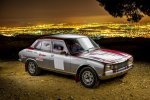 National Tourism photo.jpg101.8 KB · Views: 10,045
National Tourism photo.jpg101.8 KB · Views: 10,045 -
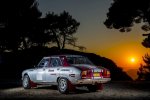 three quarter rear view.jpg78.1 KB · Views: 2,371
three quarter rear view.jpg78.1 KB · Views: 2,371 -
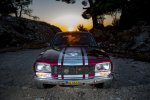 top view.jpg99.3 KB · Views: 4,085
top view.jpg99.3 KB · Views: 4,085 -
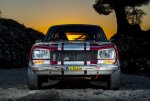 front view.jpg98.5 KB · Views: 5,706
front view.jpg98.5 KB · Views: 5,706 -
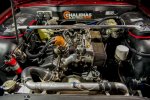 engine bay.jpg102.3 KB · Views: 9,573
engine bay.jpg102.3 KB · Views: 9,573 -
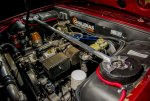 engine bay fire protection.jpg100.6 KB · Views: 4,705
engine bay fire protection.jpg100.6 KB · Views: 4,705 -
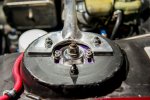 adjustable top mount.jpg78.7 KB · Views: 2,278
adjustable top mount.jpg78.7 KB · Views: 2,278 -
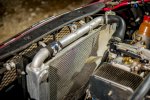 radiator & oil cooler.jpg100.9 KB · Views: 2,570
radiator & oil cooler.jpg100.9 KB · Views: 2,570 -
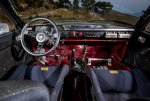 cockpit rear view.jpg98.6 KB · Views: 3,958
cockpit rear view.jpg98.6 KB · Views: 3,958 -
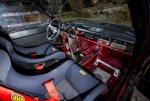 cockpit.jpg99 KB · Views: 3,213
cockpit.jpg99 KB · Views: 3,213 -
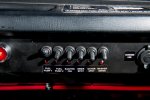 control switches.jpg75.2 KB · Views: 2,638
control switches.jpg75.2 KB · Views: 2,638 -
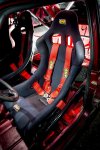 front seats.jpg99.8 KB · Views: 1,666
front seats.jpg99.8 KB · Views: 1,666 -
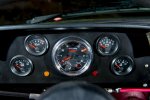 instrument panel.jpg80 KB · Views: 3,203
instrument panel.jpg80 KB · Views: 3,203 -
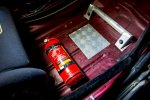 manual fire extinguisher.jpg86.6 KB · Views: 1,997
manual fire extinguisher.jpg86.6 KB · Views: 1,997 -
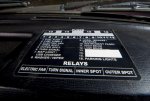 relay & fuse legend.jpg91 KB · Views: 1,787
relay & fuse legend.jpg91 KB · Views: 1,787 -
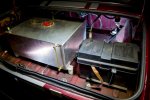 explosion proof fuel tank & battery box.jpg86.4 KB · Views: 2,242
explosion proof fuel tank & battery box.jpg86.4 KB · Views: 2,242 -
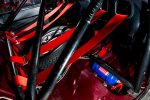 rear auto fire extinguisher.jpg83.3 KB · Views: 2,197
rear auto fire extinguisher.jpg83.3 KB · Views: 2,197 -
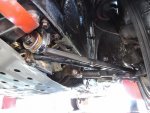 adjustable control arms.jpg93.3 KB · Views: 2,524
adjustable control arms.jpg93.3 KB · Views: 2,524 -
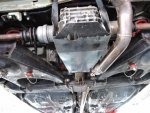 differential guard.jpg94.6 KB · Views: 5,687
differential guard.jpg94.6 KB · Views: 5,687 -
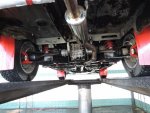 stainless exhaust.jpg93.9 KB · Views: 4,476
stainless exhaust.jpg93.9 KB · Views: 4,476 -
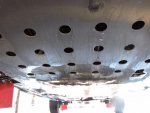 full length sump guard.jpg66.2 KB · Views: 1,624
full length sump guard.jpg66.2 KB · Views: 1,624 -
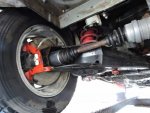 seam welded swing arms.jpg85.6 KB · Views: 4,069
seam welded swing arms.jpg85.6 KB · Views: 4,069 -
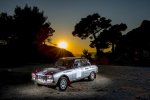 three quarter front view.jpg76.4 KB · Views: 1,596
three quarter front view.jpg76.4 KB · Views: 1,596
Last edited:

